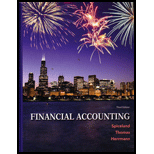
Financial Accounting
3rd Edition
ISBN: 9780078025549
Author: J. David Spiceland, Wayne M Thomas, Don Herrmann
Publisher: McGraw-Hill Education
expand_more
expand_more
format_list_bulleted
Concept explainers
Textbook Question
Chapter 6, Problem 6.6BE
Calculate ending inventory and cost of goods sold using LIFO (LO6–3)
Refer to the information in BE6–5. Calculate ending inventory and cost of goods sold for the year, assuming the company uses LIFO.
Expert Solution & Answer
Want to see the full answer?
Check out a sample textbook solution
Students have asked these similar questions
Please provide the accurate answer to this general accounting problem using appropriate methods.
None
Please provide the solution to this general accounting question with accurate financial calculations.
Chapter 6 Solutions
Financial Accounting
Ch. 6 - Prob. 1RQCh. 6 - Prob. 2RQCh. 6 - What is the difference among raw materials...Ch. 6 - Prob. 4RQCh. 6 - Prob. 5RQCh. 6 - What is a multiple-step income statement? What...Ch. 6 - Cheryl believes that companies report cost of...Ch. 6 - What are the three primary cost flow assumptions?...Ch. 6 - 9.Which cost flow assumption generally results in...Ch. 6 - Prob. 10RQ
Ch. 6 - Prob. 11RQCh. 6 - 12.Explain how LIFO generally results in lower...Ch. 6 - Prob. 13RQCh. 6 - Explain how freight charges, purchase returns, and...Ch. 6 - Prob. 15RQCh. 6 - Prob. 16RQCh. 6 - Prob. 17RQCh. 6 - Prob. 18RQCh. 6 - Prob. 19RQCh. 6 - How is gross profit calculated? What is the gross...Ch. 6 - 21.Explain how the sale of inventory on account is...Ch. 6 - Prob. 22RQCh. 6 - Prob. 23RQCh. 6 - Prob. 24RQCh. 6 - Prob. 6.1BECh. 6 - Prob. 6.2BECh. 6 - Calculate cost of goods sold (LO62) At the...Ch. 6 - Prob. 6.4BECh. 6 - Calculate ending inventory and cost of goods sold...Ch. 6 - Calculate ending inventory and cost of goods sold...Ch. 6 - Calculate ending inventory and cost of goods sold...Ch. 6 - Prob. 6.8BECh. 6 - Identify financial statement effects of FIFO and...Ch. 6 - Prob. 6.10BECh. 6 - Prob. 6.11BECh. 6 - Prob. 6.12BECh. 6 - Prob. 6.13BECh. 6 - Prob. 6.14BECh. 6 - Prob. 6.15BECh. 6 - Prob. 6.16BECh. 6 - Prob. 6.17BECh. 6 - Prob. 6.18BECh. 6 - Prob. 6.19BECh. 6 - Prob. 6.20BECh. 6 - Prob. 6.21BECh. 6 - Prob. 6.22BECh. 6 - Calculate cost of goods sold (LO62) Russell Retail...Ch. 6 - Prob. 6.2ECh. 6 - Prob. 6.3ECh. 6 - Calculate inventory amounts when costs are rising...Ch. 6 - Calculate inventory amounts when costs are...Ch. 6 - Record Inventory transactions using o perpetual...Ch. 6 - Record inventory purchase and purchase return...Ch. 6 - Prob. 6.8ECh. 6 - Prob. 6.9ECh. 6 - Prob. 6.10ECh. 6 - Record transactions using a perpetual system...Ch. 6 - Record transactions using a perpetual system...Ch. 6 - Prob. 6.13ECh. 6 - Prob. 6.14ECh. 6 - Calculate cost of goods sold, the inventory...Ch. 6 - Prob. 6.16ECh. 6 - Prob. 6.17ECh. 6 - Prob. 6.18ECh. 6 - Record inventory purchases and sales using a...Ch. 6 - Prob. 6.20ECh. 6 - Calculate ending inventory and cost of goods sold...Ch. 6 - Prob. 6.2APCh. 6 - Prob. 6.3APCh. 6 - Prob. 6.4APCh. 6 - Prob. 6.5APCh. 6 - Prob. 6.6APCh. 6 - Prob. 6.7APCh. 6 - Prob. 6.8APCh. 6 - Record transactions and prepare a partial income...Ch. 6 - Prob. 6.10APCh. 6 - Calculate ending inventory and cost of goods sold...Ch. 6 - Prob. 6.2BPCh. 6 - Prob. 6.3BPCh. 6 - Prob. 6.4BPCh. 6 - Prob. 6.5BPCh. 6 - Prob. 6.6BPCh. 6 - Prob. 6.7BPCh. 6 - Use the inventory turnover retio end gross profit...Ch. 6 - Record transactions and prepare a partial income...Ch. 6 - Prob. 6.10BPCh. 6 - Prob. 6.1APCPCh. 6 - Prob. 6.2APFACh. 6 - Prob. 6.3APFACh. 6 - Prob. 6.4APCACh. 6 - Prob. 6.5APECh. 6 - Prob. 6.6APIRCh. 6 - Written Communication You have just been hired as...Ch. 6 - Prob. 6.8APEM
Knowledge Booster
Learn more about
Need a deep-dive on the concept behind this application? Look no further. Learn more about this topic, accounting and related others by exploring similar questions and additional content below.Similar questions
- Can you solve this general accounting problem with appropriate steps and explanations?arrow_forwardPlease explain the solution to this general accounting problem with accurate explanations.arrow_forwardCan you solve this general accounting question with the appropriate accounting analysis techniques?arrow_forward
- Please provide the answer to this general accounting question with proper steps.arrow_forwardCan you help me solve this general accounting question using valid accounting techniques?arrow_forwardI am trying to find the accurate solution to this general accounting problem with the correct explanation.arrow_forward
arrow_back_ios
SEE MORE QUESTIONS
arrow_forward_ios
Recommended textbooks for you
- Principles of Accounting Volume 1AccountingISBN:9781947172685Author:OpenStaxPublisher:OpenStax College
 Survey of Accounting (Accounting I)AccountingISBN:9781305961883Author:Carl WarrenPublisher:Cengage Learning
Survey of Accounting (Accounting I)AccountingISBN:9781305961883Author:Carl WarrenPublisher:Cengage Learning Cornerstones of Financial AccountingAccountingISBN:9781337690881Author:Jay Rich, Jeff JonesPublisher:Cengage Learning
Cornerstones of Financial AccountingAccountingISBN:9781337690881Author:Jay Rich, Jeff JonesPublisher:Cengage Learning  College Accounting (Book Only): A Career ApproachAccountingISBN:9781337280570Author:Scott, Cathy J.Publisher:South-Western College Pub
College Accounting (Book Only): A Career ApproachAccountingISBN:9781337280570Author:Scott, Cathy J.Publisher:South-Western College Pub

Principles of Accounting Volume 1
Accounting
ISBN:9781947172685
Author:OpenStax
Publisher:OpenStax College

Survey of Accounting (Accounting I)
Accounting
ISBN:9781305961883
Author:Carl Warren
Publisher:Cengage Learning

Cornerstones of Financial Accounting
Accounting
ISBN:9781337690881
Author:Jay Rich, Jeff Jones
Publisher:Cengage Learning

College Accounting (Book Only): A Career Approach
Accounting
ISBN:9781337280570
Author:Scott, Cathy J.
Publisher:South-Western College Pub

Chapter 6 Merchandise Inventory; Author: Vicki Stewart;https://www.youtube.com/watch?v=DnrcQLD2yKU;License: Standard YouTube License, CC-BY
Accounting for Merchandising Operations Recording Purchases of Merchandise; Author: Socrat Ghadban;https://www.youtube.com/watch?v=iQp5UoYpG20;License: Standard Youtube License